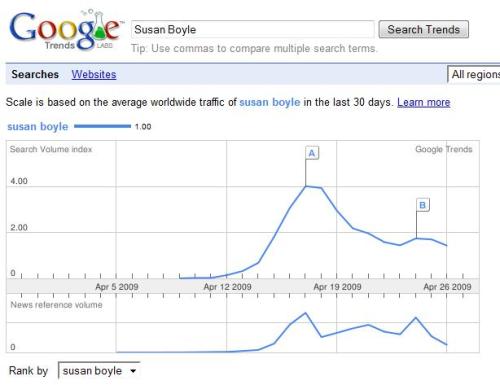It is the foolhardy prerogative for any journalist to want to be at the epicentre of all the action. Arguably in the case of swine-flu it is less so.
However, having spent the past fortnight working at The Scotsman in Edinburgh, I found myself in the middle of something equally viral; the Susan Boyle effect.
I am fully aware of the global nature of the sensation that is Susan Boyle but, what with her being oh so very Scottish, I can’t help feeling I had my head right next to the speaker on this one.
In a totally unprecedented form of self-harm, I shall take this opportunity to continue the now thoroughly worn out discussion of the ruddy-cheeked singing sensation. Namely, because my overexposure to the Boyle-effect made me think, once again, about digital media and how journalists are now producing and gathering news.
One look at Google Trends shows the search patterns for Susan Boyle. It also shows the news reference volume. This is a perfect example of how web users have dictated the news content by creating an overnight celebrity. For over a week she had more searches than Britney Spears, Cheryl Cole, Angelina Jolie and Salma Hayek – combined.
As marketing expert Niall McKinney, CEO of utalkmarketing.co.uk told me, in the past this level of global recognition would have taken tens of millions of pounds to generate and quite frankly, it wouldn’t have happened. Certainly not in the space of 11 days (as it was at the time).
Journalists had immediate and ongoing knowledge of just how interested the public were in Susan Boyle, and they capitalised on that. Fair game, and I’m sure ITV are happy.
What interests me however, is the blurring of lines between how the agenda of news is set, the extent to which journalists feed into trends or whether they simply reflect them.
Journalists are aware of the massive influence they have in driving trends and this is why press officers regularly regurgitate into reporter’s mailboxes. But in a struggling industry we also need to remember to take on board the current interests and trends that are driving our audience. Websites such as twitter and tools like Google Trends allow us to do this.
The problem lies in an increasingly complex relationship between branding and advertising agencies and the media. As agencies discover more innovative and subversive tactics to get their message across, it becomes more difficult to identify the real interests of our audience and seemingly natural trends that have actually been cultivated in other ways.
Although these tools will never replace traditional journalism, they can help reporters identify with their readers requirements and interests, it’s up to the reporters to identify what is news and what is simply creation.



Ace post, your thoughts on journalists driving trends (and even skewing the news agenda) seem more pertinent than ever. Was anyone all that panicked about #swineflu until everyone took it upon themselves to create ever more complex and beautiful maps cataloguing, in grim detail, the exact location and nature of various outbreaks?
As for PR driving trends…I think that’s happened for some time, it’s just evolving. Look at the Budweiser ads; ironically it never made them much money.
Pingback: My so-called freelance life…from harem pants to hops. « Nicole blogs.